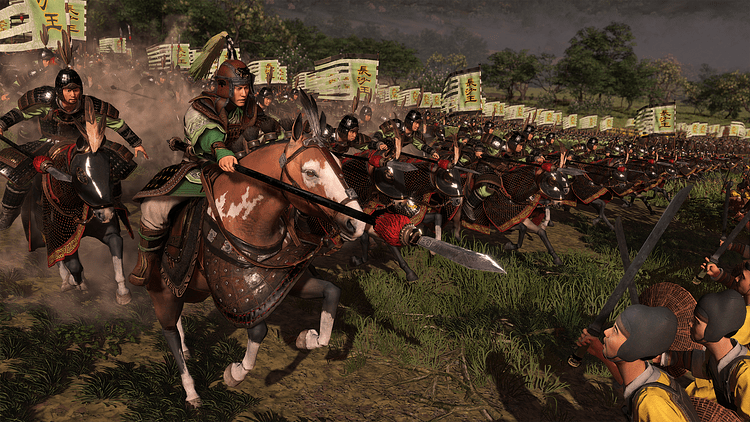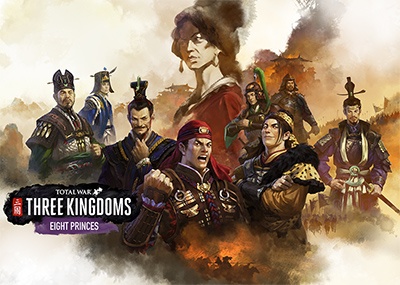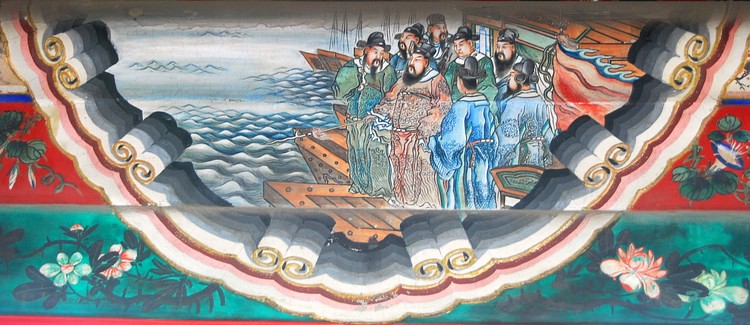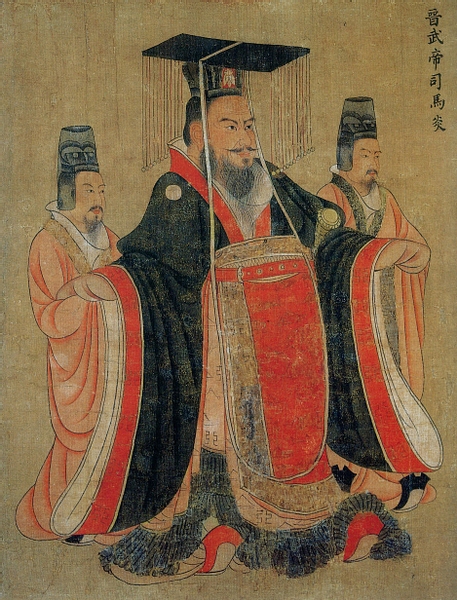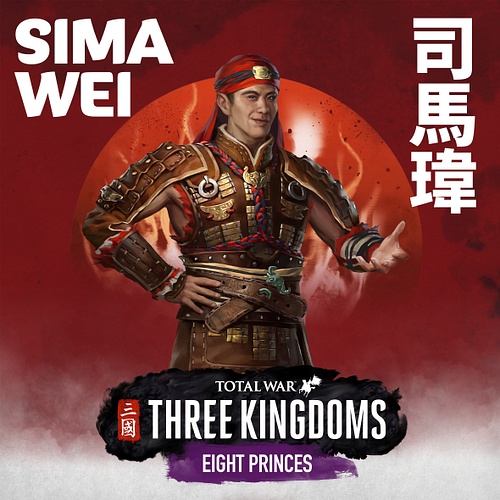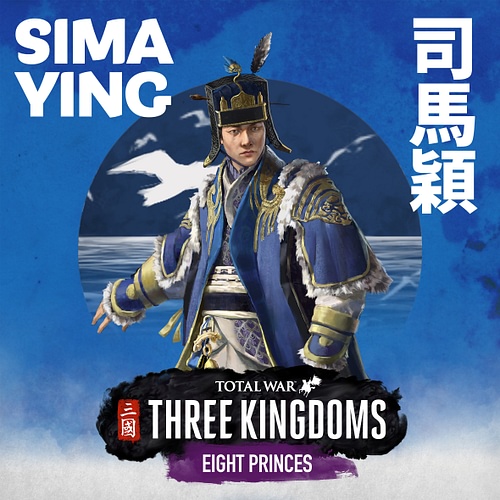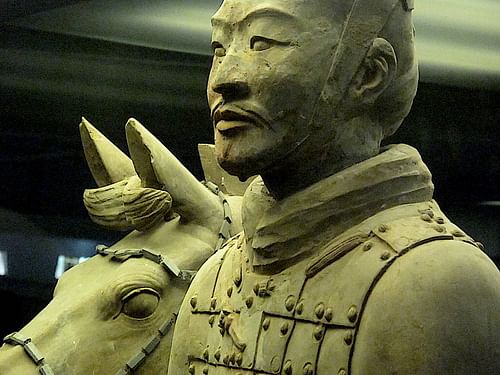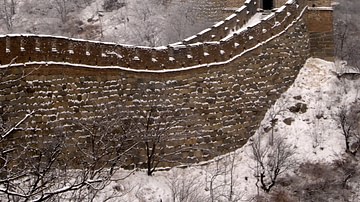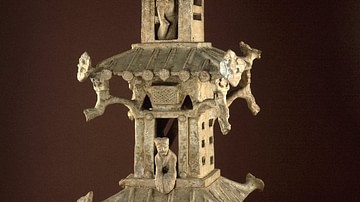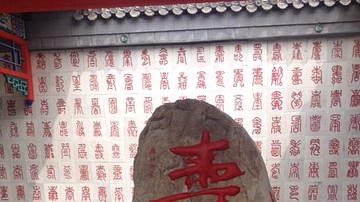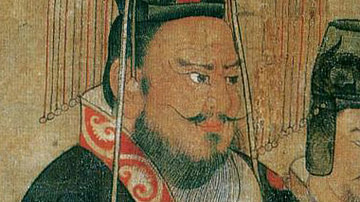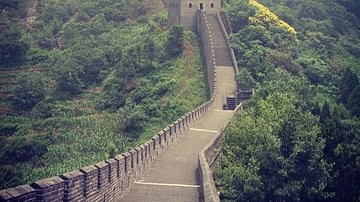The War of the Eight Princes (291-306 CE) is the conflict which weakened and finally ended the Western Jin Dynasty (266-316 CE) in China and resulted in more far-reaching consequences throughout the country. The power of the Sima family was established in the State of Wei by Sima Yi (l. 179-251 CE) during the period of the Three Kingdoms prior to the rise of the Jin Dynasty. The princes' conflict arose over who would wield the most power in the royal Sima family after the death of Emperor Wu (birth name Sima Yan, l. 236-290 CE) whose successor, Emperor Hui (birth name Sima Zhong, l. 259-307 CE), was disabled and so easily manipulated by others.
The War of the Eight Princes initially was not so much any kind of armed conflict between eight different nobles as a deadly game of chess played by the Empress Jia Nanfeng (l. 257-300 CE) and certain princes and, later, almost equal amounts of armed clashes and subtle plots and manipulations.
The Eight Princes were:
- Sima Yong, Prince of Hejian, granduncle to Emperor Wu
- Sima Jiong, Prince of Qi, cousin of Emperor Hui
- Sima Yue, Prince of Donghai, cousin of Emperor Wu
- Sima Ai, Prince of Changsha, son of Emperor Wu and a concubine
- Sima Ying, Prince of Chengdu, son of Emperor Wu and a concubine
- Sima Lun, Prince of Zhao, son of Sima Yi
- Sima Liang, Prince of Runan, son of Sima Yi
- Sima Wei, Prince of Chu, son of Emperor Wu and a concubine
All eight have come to be known by their temperament or outstanding characteristic during the conflict. Sima Wei is usually noted for his quick temper; Sima Liang for his honor and chivalry; Sima Lun as the usurper of the throne; Sima Ying for his able governance; Sima Ai for his courage and administration; Sima Yue for his bravery and tenacity; Sima Jiong for his arrogance; Sima Yong for his cleverness and resourcefulness. Their story is told in volume 59 of The Book of Jin (Jinshu, c. 648 CE) also known as The History of the Jin Dynasty.
By the time the war was over, all of these men except one would be dead, thousands of others killed, even more uprooted and left homeless, and the kingdom they fought over in ruins. In the end, after all of the bloodshed and suffering, the Western Jin Dynasty was taken by the nomadic Xiongnu and the refugees fled to form the Eastern Jin Dynasty (317-420 CE) which was succeeded by the Liu Song Dynasty (420-479 CE). The War of the Eight Princes is considered one of the bloodiest episodes in China's history and a lesson in absurd irony as the conflict arose due to efforts to prevent precisely what happened.
Rise of the Sima Family
The Han Dynasty (202 BCE - 220 CE), which had succeeded the first imperial dynasty of the Qin, steadily weakened after c. 105 CE due to various problems, including the emperor's isolation from the people and costly wars with the Xianbi nomadic peoples to the north. The armies on the frontiers were more loyal to their commanders than to the emperor and became more so as the Xianbi conflict continued to claim Chinese lives. In a Xianbi ambush in 177 CE, three-fourths of the Chinese contingent were killed. Still, Emperor Lingdi (r. 168-189 CE) insisted the war continue and taxed the peasantry heavily to pay for it.
The peasants were already dealing with multiple problems caused by flood and famine, and many landlords, unable to collect a tax from a population without resources, deserted their villages and moved with their people to other locations they then fortified. Many people could not afford this luxury, however, and the frustration they felt finally expressed itself in the Yellow Turban Rebellion of 184 CE.
The rebellion caught the emperor by surprise and he quickly empowered regional governors to raise armies to deal with the problem. The revolt was crushed the following year by the general Cao Cao but, by this time, all those governors had become warlords with their own armies who now fought each other for territory and power. The Han Dynasty fell and was replaced by the chaotic period known as the Three Kingdoms (220-280 CE) comprised of Cao Wei, Eastern Wu, and Shu Han, all of whom then warred with each other.
Sima Yi was chancellor and co-regent of the state of Wei but, after a coup in 249 CE, assumed full political and military authority. Sima Yi was a great strategist who had been responsible for Cao Cao's political and military victories and now used those same skills to consolidate his power and provide for the succession of his son Sima Shi (l. 208-255 CE) and, after him, Sima Zhao (l. 211-265 CE). Although the Sima family members were now the power behind the government, there was still an emperor on the Wei throne, Cao Huan (r. 260-266 CE). Sima Zhao's son, Sima Yan, convinced Cao Huan to abdicate in his favor and then founded the Jin Dynasty, taking the throne name of Emperor Wu of Jin.
Background to the Troubles
At some point shortly after Sima Yan assumed the throne, the Xianbi were defeated and subjugated by another nomadic people known as the Xiongnu. C. 280 CE, the Xiongnu raided the Yellow River basin and nothing was done to stop them. Those who could have mounted a defense had no power to do so and, by the time the emperor was aware of the raid, the damage had been done and the Xiongnu were safely back in their own territory.
Emperor Wu, drawing on lessons of the past, recognized how a large part of the Han Dynasty's problems toward the end was the emperor's isolation from his people and the military. In order to prevent any similar chaos in the future – as well as deal with problems at hand such as another Xiongnu raid - Emperor Wu appointed 27 of his relatives princes and gave them their own kingdoms, complete with armies, which were to be kept at a maximum of 5,000 men for larger kingdoms, with smaller kingdoms keeping fewer but still substantial forces. This policy, he seems to have thought, would provide maximum stability in that every kingdom he reigned over was under the direct control of a family member who owed him everything and would remain loyal. There would be no need to fear unruly warlords in far-off districts marching against him nor would there be any peasant revolts as each prince would take care of the people in their own kingdom.
Wu's plan worked well on paper but, in practice, the peasants suffered more as they were conscripted into each prince's army and each prince cared more about his own power and kingdom than the welfare of the state overall or the people of their kingdoms. These problems would become compounded by the mental faculties of the emperor's son and successor, Sima Zhong. Emperor Wu had two sons by his first wife Yang Yan (l. 238-274 CE), Sima Gui (who died young) and Sima Zhong who was made crown prince. Sima Zhong is often characterized as 'weak' or 'incapable' but would be diagnosed today as developmentally disabled. He seems to have functioned at a rudimentary level and struggled with basic conversation and decision-making skills.
Emperor Wu's advisors called his attention to his son's disability, but Wu ignored them. Wu arranged his son's marriage to Jia Nanfeng, daughter of Jia Chong (l. 217-282 CE), a long-standing family friend, court-appointed duke, and advisor to the emperor. Jia Nanfeng is routinely characterized as conniving, jealous, petty, and ruthless, and she showed a talent for duplicity at an early age. She was 14 when she married the 12-year old Sima Zhong and, shortly after, the emperor finally paid attention to his advisors and questioned whether his son was capable of succeeding him, initiating a policy of sending the boy written queries he should answer. Jia Nanfeng was able to easily put Emperor Wu's fears to rest by writing - or having servants write - responses which the emperor found impressive.
Emperor Wu's first wife died in 274 CE, and he married Yang Zhi (l. 259-292 CE) daughter of his advisor Yang Jun (d. 291 CE) whom the emperor had made regent for Sima Zhong. When Emperor Wu died in 290 CE, Sima Zhong became Emperor Hui of Jin but, incapable of rule, he swiftly became the most valuable pawn in the game to seize and hold power.
Jia Nanfeng Moves First
Yang Zhi, as the late emperor's widow and new emperor's stepmother, initially exerted the greatest hold over Hui and capitalized on this by empowering her father's position as regent. To Jia Nanfeng, the new empress, this situation was intolerable and she wrote to Sima Liang (d. 291 CE) and Sima Wei (d. 291 CE) to come to the capital at Luoyang to help her. Sima Wei arrived with his army, unopposed by those of the central government, and Jia Nanfeng accused Yang Jun of treason. Although history treats her pretty much as she seems to have deserved, she was actually right in this – almost certainly without knowing it – as Yang Jun had earlier changed Emperor Wu's will to profit himself and enlarge his position.
Using her old method of writing under her husband's name, Jia Nanfeng issued an edict denouncing Yang Jun and ordering Sima Wei to attack Yang's troops. While this was going on, Yang Zhi wrote her own edicts which she then fired from the palace windows denouncing Jia Nanfeng and demanding help. Jia Nanfeng accused her of treason and, after the defeat of Yang Jun's troops and his execution, Yang Zhi was placed under house arrest and starved to death. Thousands of Yang family members and supporters were then executed.
Sima Liang then took control to keep the peace but, as he had rejected Jia Nanfeng's earlier offer to topple the Yangs, she forged another imperial edict under her husband's name accusing Sima Liang of treason, and he was killed by Sima Wei. She then let word spread that Sima Wei had forged the edict and Sima Liang had been innocent. Sima Wei lost face, was deserted by his followers, and was soon executed.
Sima Lun Moves Next
Jia Nanfeng's manipulations had worked just as she had hoped, but there was another obstacle in her path to complete control: Sima Yu (l. 278-300 CE), her stepson. Emperor Wu had given Sima Zhong a concubine, Xie Jiu, to teach him about sex, and Sima Yu was their son and so the legitimate crown prince since Jia Nanfeng had thus far been unable to produce a male heir. Jia Nanfeng invited Sima Yu to the palace for a feast and, once he was drunk, had him write out a plan to kill Emperor Hui and herself and have himself made emperor. She then presented this document to her husband and demanded Sima Yu be executed. Emperor Hui refused to kill his son and instead had him demoted to the status of a commoner.
The prince Sima Lun (d. 301 CE) of Zhao was one of Jia Nanfeng's confidantes but had actually been waiting for a chance to destroy her. He suggested to Jia Nanfeng that she should kill Sima Yu before the young man had a chance to plead his case to his father, possibly exposing her. Jia Nanfeng took his advice, killed her stepson, and was then surprised by Sima Lun's edict accusing her of treason and murder. He forced her to commit suicide, slaughtered her family and supporters, and had Emperor Hui placed under house arrest, declaring himself emperor in 301 CE.
War of the Princes
Sima Jiong (d. 302 CE), Sima Ying (d. 306 CE), and Sima Yong (d. 306 CE) joined forces against Sima Lun, defeated his armies, and forced him to commit suicide. Afterwards, in keeping with policy, they massacred his supporters and family, and Sima Jiong restored Emperor Hui to power. Sima Jiong gave himself all the powers of the emperor, though allegedly acting on Emperor Hui's interests, and rewarded Sima Ying and Sima Yong with high positions to keep them content.
Sima Yong was dissatisfied with Sima Jiong's pretensions, however, and so launched a plot to put himself in power. He concocted the story that Sima Ai (d. 304 CE) was plotting against Sima Jiong and let the tale spread in the hopes that Sima Jiong would destroy Sima Ai, weakening himself in the process, and would then easily fall to Sima Yong. Sima Ai was able to evade Sima Jiong's forces, however, counterattacked, and killed Sima Jiong. When Sima Yong arrived at Luoyang, he found Sima Ai in control and in command of significant forces. Sima Ai then comported himself as emperor and presumed to speak in Hui's interests.
Sima Yong bided his time in hopes of some unfortunate accident (which he tried to engineer) befalling Sima Ai, but when this did not happen, he allied himself with Sima Ying to depose Ai. Sima Ai was eventually captured and killed by Sima Yong. Sima Yue (d. 311 CE), Sima Ying, and Sima Yong all then shared in the wealth and power of the capital. Sima Yue was jealous of the wealth of Sima Ying, however, and convinced Emperor Hui that he was disloyal and planning a coup. Yue and Hui joined forces against Ying but were defeated and Hui taken prisoner by Ying.
Sima Ying took Hui to Luoyang, then under the control of Sima Yong. Sima Yue regrouped and attacked, defeating Sima Yong in battle in 305 CE. Sima Ying and Sima Yong were both executed the following year and their families and supporters murdered. Emperor Hui died in 307 CE, most likely poisoned, and Sima Yue was the last prince standing, but with Emperor Hui's death, the throne went to the next blood relative, one Sima Chi (known posthumously as Emperor Huai, l. 284-313 CE), the youngest son of Emperor Wu and one of his concubines. Sima Yue died in 311 CE from uncertain causes but, considering the amount of trouble he caused Emperor Huai, he was most likely poisoned.
Conclusion
Throughout the latter part of the War of the Eight Princes (c. 300-306 CE), the various antagonists often employed mercenary forces of the very Xiongnu who had inspired Emperor Wu to empower the princes with their own kingdoms and armies. After Sima Yue's death in 311 CE, Luoyang was taken by the Xiongnu leader Liu Cong (d. 318 CE) who executed Sima Chi in 313 CE. Sima Chi was succeeded by Sima Ye (known posthumously as Emperor Min, d. 318 CE) who surrendered to the Xiongnu in 316 CE and was executed two years later.
The rapid decline of Western Jin between 300-304 CE gave rise to the nebulous period known as the Sixteen Kingdoms (c. 304-439 CE) during which foreign “barbarian” tribes, including the Xiongnu, established their own domains throughout China concurrent with Chinese dynasties. The survivors of the Western Jin court were forced to flee Luoyang and established the Eastern Jin Dynasty in 317 CE at Jiankang (modern-day Nanjing), but it was just as rife with corruption and intrigue as the old court had been and, further, met with resistance from clans already established in the region who were used to their own form of government. Even so, they managed to retain rule until 420 CE when they were deposed by Liu Yu (l. 363-422 CE) who founded the Liu Song Dynasty.
The War of the Eight Princes is a fitting coda to the period of the Three Kingdoms which was marked by the same level of brutality as the path to power and the same lack of regard for the common people each faction claimed they represented. In both periods, the aristocracy used the common people as fodder in their senseless battles to aggrandize themselves when they could have as easily put the same effort into actually raising the standard of living in the country and improving, rather than destroying, lives.
In the end, in both cases, the antagonists betrayed their own professed ideals through their selfishness and lust for power. Although the period of the Three Kingdoms, especially, and the War of the Eight Princes, to a lesser degree, have long been romanticized in literature, there is little any Chinese peasant of the time would have found romantic in either.
